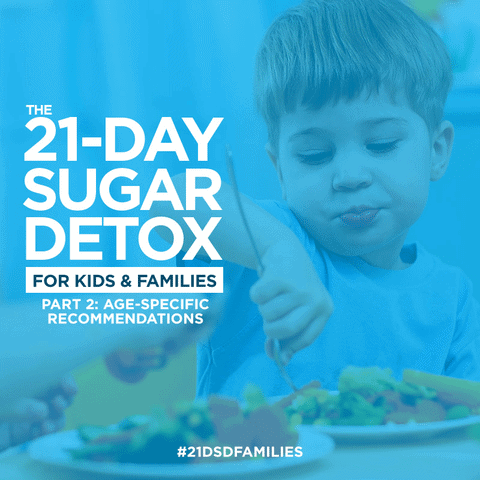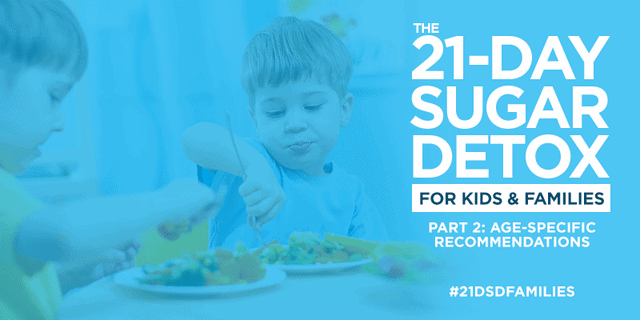This is Part 2 of a 3-part series. You can read Part 1 here.
If you’ve decided that the 21-Day Sugar Detox is right for your family, you may be wondering how to tailor it to your children’s specific needs. A small child eats much differently and has different nutritional and developmental requirements from a teenager, and adjusting their 21DSD to suit these needs is of utmost importance for their health and for family harmony.
Here are some age-specific recommendations for how to feed your kids with 21DSD principles in mind.
#1 Babies
The detox is not appropriate for babies, who should be eating breastmilk and some solid foods sometime between 5-12 months old. If you are unable to breastfeed, consider making your own baby formula (The Weston A. Price Foundation has several baby formula recipes that are nutrient-dense, whole food options for those who can’t breastfeed) instead of using store-bought formulas, which are often sweetened and contain other ingredients that we are trying to avoid (such as soy, vegetable oils, and conventionally raised milk products).
If you are a breastfeeding mother, you need to make sure you eat enough total calories as well as 1⁄2 cup sweet potato, butternut squash, or other starchy vegetable (see the starchy vegetables list in The 21-Day Sugar Detox Daily Guide) at each meal of the day to maintain your milk supply and provide enough nutrients for your growing baby and your own body.
If you are introducing solid foods, consider feeding your baby those foods that are nutrient-dense and easily digested. Some suggested first foods include pureed or mashed avocado, sweet potato or other winter squash, banana, egg yolks, and well-cooked meats including grassfed liver. You should also add in healthy fats like butter or ghee, coconut oil, and other animal fats. Notice I didn’t include any grains? Cultures all over the world forego the grains as first foods and instead choose more nutrient-dense and flavorful options. Your baby won’t miss anything if you opt out of the rice cereal. It should also be said that sweeteners of any kind are not appropriate for babies and should never be part of their diets.
#2 Kids 1-4
 Kids at this age are rapidly growing and expanding their palates. They may be eager food explorers or resistant eaters (or both in the same day), but as a parent you can shape what they put in their mouths. It is also very normal for kids to want all their foods separated on a plate or all in one color scheme. Do your best to work with these developmental phases while encouraging them to try new foods without pressure.
Kids at this age are rapidly growing and expanding their palates. They may be eager food explorers or resistant eaters (or both in the same day), but as a parent you can shape what they put in their mouths. It is also very normal for kids to want all their foods separated on a plate or all in one color scheme. Do your best to work with these developmental phases while encouraging them to try new foods without pressure.
All detox foods are appropriate for this age/stage, but you need to provide more fruit and starchy vegetables. Remember that a serving size for a child this age is roughly one-third to one-half the size of an adult serving. However, kids do go through growth spurts when they seem to eat endlessly (followed by periods when they hardly seem to eat at all). Offer a variety of 21DSD-approved foods and allow your kids to decide how much they want to eat. Each meal should include protein, a healthy fat, a starchy vegetable, and a non-starchy vegetable or fruit.
If your child is in a daycare or preschool setting, you may need to talk to the supervisors and arrange to bring alternate snacks for the duration of the detox (or indefinitely). It is not advisable to describe your “new” food choices as a detox program or diet since those are not recommended feeding options for children. And in reality, you are not truly “detoxing” your child; you are providing an alternate, sugar-free eating plan to improve nutrition, behavior and digestion. If you’re not sure what to say, tell interested parties that you are going “sugar-free.”
#3 Kids 5-12
In this age range, kids are going to school, eating at friends’ houses, and out of your range of influence for parts of the day. It might be difficult to control everything that goes into their mouths, but you can provide detox-friendly breakfasts and dinners at home and pack detox-friendly lunches and snacks while they are away. For the older children, you can discuss why you are changing some of the foods they might be eating and help them to understand how food affects their bodies’ ability to grow properly, their brains’ ability to function clearly, and their behavior and emotions.
As with younger children, kids this age need more carbohydrates than adults since they are growing (especially as they hit puberty). Build meals similar to your adult meals (protein+healthy fat+vegetables) with choices that reflect your kids’ taste preferences and with the inclusion of starchy vegetables at most meals. You may also want to allow more fruit servings/variety.
#4 Teenagers
While teenagers are almost adults, and many of them believe that they have already arrived at adulthood, developmentally they are still growing and changing, and therefore need to be sure to get a nutrient-dense diet. However, they will want to be more in control of their eating choices and might be away from home for extended periods of time. If you want your teenagers to participate in the 21DSD, understand that they will be most successful if they choose to participate rather than if they are forced to. If they are resistant, you can certainly remove NO foods from the house, provide detox-friendly breakfasts and dinners, and discuss how the detox is making you feel, sleep, etc. Be flexible and don’t push—you are still the parent and you make the food choices at home, but they are becoming more independent and need to learn to make their own decisions, including those that involve food. You might also need to accept the fact that they may load up on sugary foods while at school or friends’ houses, in which case keeping the lines of communication open will help them understand that you are trying to help them be healthy and successful in all areas of their lives.
At this point, if a teenager is very active or on the younger side (13-16 or so), I would still provide starchy carbohydrates at least once a day, probably more. They will also be eating adult-size portions, and maybe more as they go through growth spurts. However, as they get older, their growth will eventually slow and they will not need as much fruit or starchy vegetables to maintain their energy and their bodies’ ability to grow. Watch them closely, though, and provide more dense carbs if you see major changes in sleep, behavior, or energy levels. Even studying requires a lot of energy output!
#5 21DSD kid-friendly food options
When starting a 21DSD, rethinking your food choices can be quite daunting, especially if you are used to eating a lot of refined grain products or sugary treats. Finding 21DSD-friendly kid snacks can be even more challenging. Below you will find some options that kids will love!
kid- friendly drinks
- Coconut water
- Raw cow’s milk (if your children consume dairy and have access to it raw)
- Mineral water
- Herbal tea (probably iced; peppermint and unsweetened fruity ones are favorites)
- Coconut milk (the light variety is more palatable as a drink)
- Kombucha (try Diane’s home-brewed Kombucha recipe)
- Smoothies
kid friendly snacks
- Raw vegetables with guacamole or cauliflower/traditional hummus
- Green apple or celery with nut butter
- Coconut-flour muffins or biscuits
- Smoothies (try this one)
- Plain full-fat organic yogurt with banana or apple and cinnamon
- Sugar-free beef jerky
- Whole nuts and seeds
- Nut mix or grain free granola
- Deli meat roll-ups
- Olives
- Steamed sweet potatoes
- Sweet potato fries
- Plantain chips (fried in coconut oil),
- Cheese (if they tolerate dairy well),
- Coconut butter truffles or lemon vanilla melt-aways
- Almond, coconut flour or pumpkin pancakes
- Toasted coconut flakes
- Roasted seaweed
kid friendly meals
- Whatever you are eating! Adjust portion sizes and preparation when relevant.
- Here are some Recipe Roundups that are kid-friendly: Kid-Friendly, Back to School, Packable Lunches, & Halloween
Sources:
- The Weston A. Price Foundation
- The Family Nutrition Book by William Sears, M.D.
- Balanced Bites & The 21-Day Sugar Detox Daily Guide
 Rebekah Reddy is mom to her three children (two girls, one boy), content development support member of Team Diane, and a part-time high school English/ESL teacher. She holds a BA in English with a minor in Spanish, an MA in English with an emphasis in Teaching English to Speakers of Other Languages (TESOL), and a California teaching credential. She is also a certified Nutrition Educator, 21DSD Certified Coach, and the author of the blog Half Indian Cook through which she shares recipes and writes about food and culture in her mixed-ethnicity family. Rebekah’s passion for delicious, nutritious food has led her entire family to improved health and happiness!
Rebekah Reddy is mom to her three children (two girls, one boy), content development support member of Team Diane, and a part-time high school English/ESL teacher. She holds a BA in English with a minor in Spanish, an MA in English with an emphasis in Teaching English to Speakers of Other Languages (TESOL), and a California teaching credential. She is also a certified Nutrition Educator, 21DSD Certified Coach, and the author of the blog Half Indian Cook through which she shares recipes and writes about food and culture in her mixed-ethnicity family. Rebekah’s passion for delicious, nutritious food has led her entire family to improved health and happiness!

